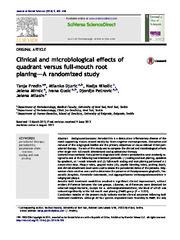Clinical and microbiological effects of quadrant versus full-mouth root planing-A randomized study
2014
Аутори
Predin, TanjaĐurić, Milanko
Nikolić, Nadja

Mirnić, Jelena
Gušić, Ivana

Petrović, Đorđe
Milašin, Jelena

Чланак у часопису (Објављена верзија)
Метаподаци
Приказ свих података о документуАпстракт
Background/purpose: Periodontitis is a destructive inflammatory disease of the tooth-supporting tissues caused mainly by Gram-negative microorganisms. Disruption and removal of the subgingival biofilm are the primary objectives of cause-related initial periodontal therapy. The aim of this study was to compare the clinical and microbiological effects after single-visit full-mouth debridement and quadrantwise therapy. Materials and methods: Forty patients diagnosed with chronic periodontitis were randomly assigned to one of the following two treatment protocols: (1) scaling and root planing, quadrant by quadrant, at 1-week intervals and (2) full-mouth scaling and root planing performed in 2 consecutive days. Plaque index, gingival index (GI), papilla bleeding index, probing depth, and clinical attachment level were used to assess the periodontal status of the patients. Polymerase chain reaction was used to determine the presence of Porphyromonas gingivalis, Tannerella forsythia, Prevotel...la intermedia, and Aggregatibacter actinomycetemcomitans in subgingival plaque. Results: Both treatment modalities resulted in significant clinical improvement, without evident difference between the two groups. Likewise, no differences were detected for selected target bacteria, except for A. actinomycetemcomitans, the level of which was reduced significantly in the full-mouth root planing (FMRP) group (P = 0.007). Conclusion: Results of the present study indicate similar clinical outcomes following both treatment modalities. Although all four species responded more favorably to FMRP, the only statistically significant decrease was recorded in the case of A. actinomycetemcomitans after therapy in this group of patients.
Кључне речи:
periodontal therapy / periodontitis / polymerase chain reaction / scaling and root planingИзвор:
Journal of Dental Sciences, 2014, 9, 4, 400-406Издавач:
- Elsevier Taiwan, Taipei
Финансирање / пројекти:
- Генетичка контрола и молекуларни механизми у малигним, инфламаторним и развојним патологијама орофацијалне регије (RS-MESTD-Basic Research (BR or ON)-175075)
DOI: 10.1016/j.jds.2013.06.005
ISSN: 1991-7902
WoS: 000347131400014
Scopus: 2-s2.0-84919842926
Колекције
Институција/група
Stomatološki fakultetTY - JOUR AU - Predin, Tanja AU - Đurić, Milanko AU - Nikolić, Nadja AU - Mirnić, Jelena AU - Gušić, Ivana AU - Petrović, Đorđe AU - Milašin, Jelena PY - 2014 UR - https://smile.stomf.bg.ac.rs/handle/123456789/1892 AB - Background/purpose: Periodontitis is a destructive inflammatory disease of the tooth-supporting tissues caused mainly by Gram-negative microorganisms. Disruption and removal of the subgingival biofilm are the primary objectives of cause-related initial periodontal therapy. The aim of this study was to compare the clinical and microbiological effects after single-visit full-mouth debridement and quadrantwise therapy. Materials and methods: Forty patients diagnosed with chronic periodontitis were randomly assigned to one of the following two treatment protocols: (1) scaling and root planing, quadrant by quadrant, at 1-week intervals and (2) full-mouth scaling and root planing performed in 2 consecutive days. Plaque index, gingival index (GI), papilla bleeding index, probing depth, and clinical attachment level were used to assess the periodontal status of the patients. Polymerase chain reaction was used to determine the presence of Porphyromonas gingivalis, Tannerella forsythia, Prevotella intermedia, and Aggregatibacter actinomycetemcomitans in subgingival plaque. Results: Both treatment modalities resulted in significant clinical improvement, without evident difference between the two groups. Likewise, no differences were detected for selected target bacteria, except for A. actinomycetemcomitans, the level of which was reduced significantly in the full-mouth root planing (FMRP) group (P = 0.007). Conclusion: Results of the present study indicate similar clinical outcomes following both treatment modalities. Although all four species responded more favorably to FMRP, the only statistically significant decrease was recorded in the case of A. actinomycetemcomitans after therapy in this group of patients. PB - Elsevier Taiwan, Taipei T2 - Journal of Dental Sciences T1 - Clinical and microbiological effects of quadrant versus full-mouth root planing-A randomized study VL - 9 IS - 4 SP - 400 EP - 406 DO - 10.1016/j.jds.2013.06.005 ER -
@article{
author = "Predin, Tanja and Đurić, Milanko and Nikolić, Nadja and Mirnić, Jelena and Gušić, Ivana and Petrović, Đorđe and Milašin, Jelena",
year = "2014",
abstract = "Background/purpose: Periodontitis is a destructive inflammatory disease of the tooth-supporting tissues caused mainly by Gram-negative microorganisms. Disruption and removal of the subgingival biofilm are the primary objectives of cause-related initial periodontal therapy. The aim of this study was to compare the clinical and microbiological effects after single-visit full-mouth debridement and quadrantwise therapy. Materials and methods: Forty patients diagnosed with chronic periodontitis were randomly assigned to one of the following two treatment protocols: (1) scaling and root planing, quadrant by quadrant, at 1-week intervals and (2) full-mouth scaling and root planing performed in 2 consecutive days. Plaque index, gingival index (GI), papilla bleeding index, probing depth, and clinical attachment level were used to assess the periodontal status of the patients. Polymerase chain reaction was used to determine the presence of Porphyromonas gingivalis, Tannerella forsythia, Prevotella intermedia, and Aggregatibacter actinomycetemcomitans in subgingival plaque. Results: Both treatment modalities resulted in significant clinical improvement, without evident difference between the two groups. Likewise, no differences were detected for selected target bacteria, except for A. actinomycetemcomitans, the level of which was reduced significantly in the full-mouth root planing (FMRP) group (P = 0.007). Conclusion: Results of the present study indicate similar clinical outcomes following both treatment modalities. Although all four species responded more favorably to FMRP, the only statistically significant decrease was recorded in the case of A. actinomycetemcomitans after therapy in this group of patients.",
publisher = "Elsevier Taiwan, Taipei",
journal = "Journal of Dental Sciences",
title = "Clinical and microbiological effects of quadrant versus full-mouth root planing-A randomized study",
volume = "9",
number = "4",
pages = "400-406",
doi = "10.1016/j.jds.2013.06.005"
}
Predin, T., Đurić, M., Nikolić, N., Mirnić, J., Gušić, I., Petrović, Đ.,& Milašin, J.. (2014). Clinical and microbiological effects of quadrant versus full-mouth root planing-A randomized study. in Journal of Dental Sciences Elsevier Taiwan, Taipei., 9(4), 400-406. https://doi.org/10.1016/j.jds.2013.06.005
Predin T, Đurić M, Nikolić N, Mirnić J, Gušić I, Petrović Đ, Milašin J. Clinical and microbiological effects of quadrant versus full-mouth root planing-A randomized study. in Journal of Dental Sciences. 2014;9(4):400-406. doi:10.1016/j.jds.2013.06.005 .
Predin, Tanja, Đurić, Milanko, Nikolić, Nadja, Mirnić, Jelena, Gušić, Ivana, Petrović, Đorđe, Milašin, Jelena, "Clinical and microbiological effects of quadrant versus full-mouth root planing-A randomized study" in Journal of Dental Sciences, 9, no. 4 (2014):400-406, https://doi.org/10.1016/j.jds.2013.06.005 . .



